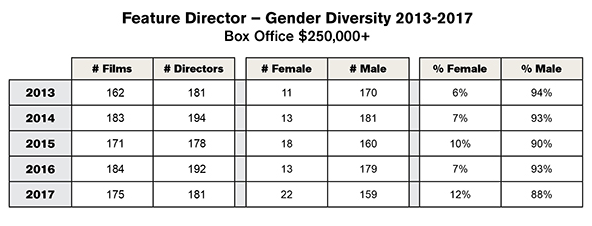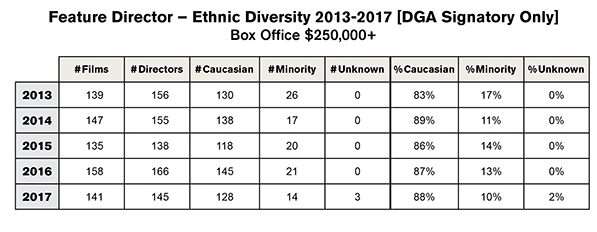“From the largest studio tent poles to the smallest indie films, diversity among feature film directors remained low in 2017,” a press release announcing the findings of a comprehensive new study from the Directors Guild of America (DGA) announced. The study’s data included the 651 feature films that were released theatrically in the U.S. last year, including those that earned less than $250,000 at the box office.
Overall, women accounted for 16 percent of directors — and the data included hundreds of micro-budget projects with limited releases. And things only get worse from there. Women accounted for just 12 percent of directors on films that took in at least $250,000. People of color accounted for only 10 percent of those directors.

DGA
The DGA didn’t focus solely on 2017. They also collected data over a five-year period from 2013-2017. As the figure above illustrates, 2017 marked the highest percentage of women-directed films to gross $250,000+ (12 percent), and 2013 offered the lowest percentage (six percent). But the percentage isn’t improving consistently every year.
Of course, $250,000+ is a huge range at the box office, and fortunately the DGA dug deeper, analyzing “box office tiers (under $10M, and over $10M) as markers to distinguish between high- and low-budget features; DGA-signatory features from the major studios; as well as all DGA-signatory projects. The percentage of women directors remained roughly consistent, ranging from eight percent to 16 percent.”
While the DGA considered directors’ ethnicity, it didn’t look at the ethnicity of female directors specifically. Unfortunately, it’s fair to assume that those percentages are the lowest. As underrepresented as women and people of color are in the biz, women of color tend to get the fewest opportunities.

DGA
In 2017, Caucasian directors helmed 88 percent of films that grossed $250,000+ at the box office. In 2013, Caucasian directors represented 83 percent of directors that took in that much. Since 2015, the percentage of minority directors has decreased every year.
Minority directors accounted for just seven percent of major studio films that took in over $10M.
“It’s outrageous that we’re once again seeing such a lack of opportunity for women and people of color to direct feature films. Our new study shows that discriminatory practices are still rampant across every corner of the feature film business,” said DGA President Thomas Schlamme.
Refreshingly, Schlamme didn’t try to present an optimistic reading of the findings or offer excuses. He recognized just how unacceptable the numbers are.
“These numbers hit home how the chips are stacked against women and people of color,” he emphasized. “We dug into our proprietary data to see if we could isolate areas that were bright spots or especially problematic. But as we kept going, it became clear that no matter how you slice the 2017 numbers, the outcome is virtually the same. There is a misconception that things are better in the smaller, indie film world, but that’s simply not the case. From financing and hiring, to distribution and agent representation – every aspect of the entire system disadvantages women and people of color.”
“Change is long overdue,” continued Schlamme. “Inclusion is a fight we’ve been fighting with the industry for four decades now, and it’s been an uphill battle to get them to change their hiring practices. In our two most recent negotiations, we pushed for the industry to adopt the Rooney Rule into their hiring practices, but they wouldn’t budge on the issue. Neither will we – we are committed to keeping at this for as long as it takes.”
On a more encouraging note, a DGA study released in September 2017 found that things are looking better for minority and female directors working on the small screen. The number of first-time female and minority episodic TV directors in the 2016-17 season marked respective increases of 13 percent and 11 percent from the previous season.







